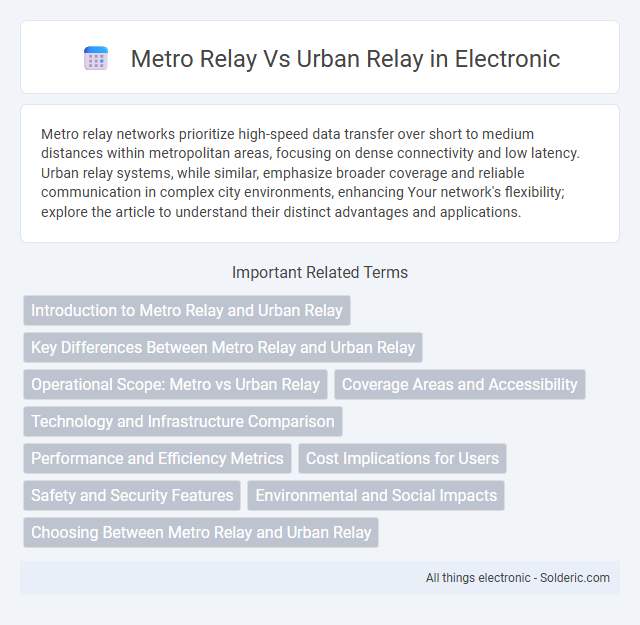Metro relay networks prioritize high-speed data transfer over short to medium distances within metropolitan areas, focusing on dense connectivity and low latency. Urban relay systems, while similar, emphasize broader coverage and reliable communication in complex city environments, enhancing Your network's flexibility; explore the article to understand their distinct advantages and applications.
Comparison Table
| Feature | Metro Relay | Urban Relay |
|---|---|---|
| Coverage Area | Medium-sized cities and suburbs | Dense urban centers and metropolitan areas |
| Network Speed | High-speed, optimized for moderate traffic | Ultra-high-speed, designed for heavy data load |
| Latency | Low latency suitable for general applications | Minimal latency for real-time services |
| Infrastructure | Fiber optics with wireless extensions | Dense fiber optic networks with advanced wireless tech |
| Use Cases | Suburban connectivity, small business support | Smart cities, high-density IoT, public transport systems |
| Scalability | Moderate scalability for growing suburbs | High scalability for expanding urban environments |
Introduction to Metro Relay and Urban Relay
Metro Relay networks serve densely populated metropolitan areas, offering high-capacity and low-latency wireless communication ideal for city infrastructure and enterprises. Urban Relay systems focus on smaller-scale, localized coverage within urban environments, optimizing connectivity for residential neighborhoods and commercial zones. Both relay types leverage advanced microwave and millimeter-wave technologies to enhance network efficiency and extend broadband access in complex urban landscapes.
Key Differences Between Metro Relay and Urban Relay
Metro relay systems typically cover larger geographic areas with higher data transmission capacities, supporting extensive network backbones and intercity connections. Urban relay networks focus on dense city environments, optimizing for shorter distances, increased node density, and enhanced signal penetration within built-up areas. Key differences include coverage range, data throughput, and deployment complexity tailored to the distinct demands of metropolitan versus urban settings.
Operational Scope: Metro vs Urban Relay
Metro relay systems operate over intermediate distances within metropolitan areas, supporting data transmission between central offices and regional hubs, typically covering ranges of up to 100 kilometers. Urban relay networks function on a more localized scale, providing high-capacity, low-latency connectivity within dense city environments, often spanning just a few kilometers. The operational scope of metro relays is broader with higher throughput demands, while urban relays prioritize agility and rapid signal distribution in complex urban infrastructures.
Coverage Areas and Accessibility
Metro relay systems typically cover densely populated metropolitan areas, providing extensive accessibility within urban cores and immediate suburbs. Urban relay networks, however, extend coverage to broader city limits and peripheral neighborhoods, ensuring connectivity in both central and outlying locations. Your choice between metro and urban relays should consider the spatial distribution of users and desired signal reach for optimal network performance.
Technology and Infrastructure Comparison
Metro relay systems utilize high-capacity fiber optic networks and dense cell site deployment to support extensive data transmission over wide metropolitan areas. Urban relay technology incorporates advanced small cell and millimeter-wave infrastructure to enhance signal strength and capacity in densely populated city environments. The infrastructure of metro relays prioritizes long-distance, high-throughput connections, while urban relays focus on localized coverage optimization and network densification.
Performance and Efficiency Metrics
Metro relay systems achieve higher data throughput and lower latency due to their optimized infrastructure for dense urban environments, supporting up to 100 Gbps links with sub-millisecond delay. Urban relay networks prioritize coverage and scalability, typically providing 10 to 40 Gbps with moderate latency around 2-5 milliseconds. Efficiency metrics highlight metro relays' energy consumption at approximately 0.5 watts per Gbps, significantly outperforming urban relays that range between 1 to 2 watts per Gbps due to broader area demands and variable load conditions.
Cost Implications for Users
Metro relay services typically offer lower fare rates compared to urban relay options due to shorter trip distances and streamlined operational routes. Urban relays often involve higher costs resulting from denser traffic, increased stops, and more complex routing requirements within city environments. Users may find metro relay more cost-effective for commuting between suburban and metropolitan areas, while urban relay costs reflect the convenience of comprehensive intra-city coverage.
Safety and Security Features
Metro relay systems prioritize robust safety and security features such as real-time fault detection, automatic isolation of affected sections, and advanced cybersecurity protocols to prevent unauthorized access. Urban relay devices integrate enhanced protection measures tailored for densely populated areas, including emergency communication capabilities, intrusion detection, and rapid response coordination with local authorities. Your choice between metro and urban relays should consider the specific safety requirements and security risks of the deployment environment to ensure optimal protection.
Environmental and Social Impacts
Metro relays reduce greenhouse gas emissions significantly by enabling more efficient power distribution in densely populated urban areas, thus minimizing energy waste and reliance on fossil fuels. Urban relays enhance public transportation networks by improving connectivity and reducing traffic congestion, leading to lower air pollution levels and improved public health. Both systems contribute to social equity by providing reliable electricity and transit access, fostering economic development and greater community resilience.
Choosing Between Metro Relay and Urban Relay
Choosing between Metro Relay and Urban Relay depends on your network scale and traffic requirements. Metro Relay excels in high-capacity, long-distance data transmission within metropolitan areas, utilizing advanced multiplexing and robust signal integrity for efficient backbone connectivity. Urban Relay is optimized for dense city environments, offering flexible, low-latency solutions tailored to localized, high-density user access and street-level deployment.
metro relay vs urban relay Infographic

 solderic.com
solderic.com